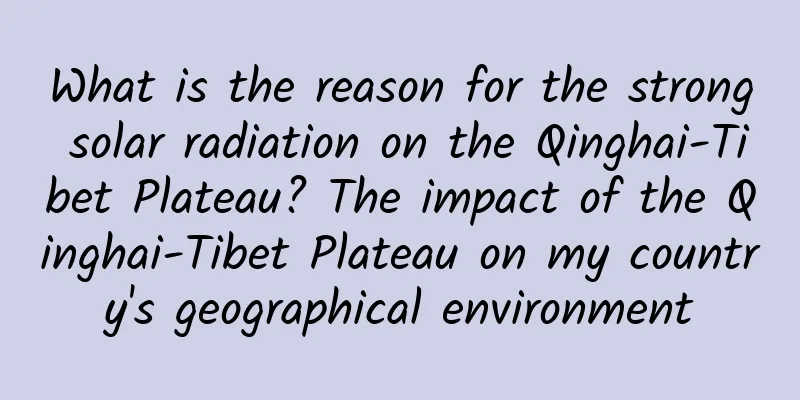What is the reason for the strong solar radiation on the Qinghai-Tibet Plateau? The impact of the Qinghai-Tibet Plateau on my country's geographical environment

|
The Qinghai-Tibet Plateau is an inland plateau in Asia. It is the largest plateau in China and the highest in the world. It is known as the "Roof of the World" and the "Third Pole". The plateau is covered with permafrost and the vegetation is mostly natural grassland. The Qinghai-Tibet Plateau blocks the South Asian monsoon from the south, so that the South Asian monsoon from the north forms strong radiation and sunshine at the southern foot of the Qinghai-Tibet Plateau. The temperature is low and the accumulated temperature is small. The temperature decreases with the increase of altitude and latitude, and the daily temperature difference is large. There is abundant precipitation, while there is almost no precipitation on the northern slope of the Qinghai-Tibet Plateau. Therefore, the boundary between the monsoon area and the non-monsoon area is formed at the southern foot of the Qinghai-Tibet Plateau. Contents of this article 1. Reasons for strong solar radiation on the Qinghai-Tibet Plateau 2. The impact of the Qinghai-Tibet Plateau on my country 3. The impact of the Qinghai-Tibet Plateau on China’s geographical environment 1The reason why solar radiation is strong on the Qinghai-Tibet PlateauBecause the Qinghai-Tibet Plateau is at a low latitude, with an average altitude of more than 4,000 meters, the atmosphere is thin, clean and thin, with little dust, less water vapor and less cloudiness, more sunny days, and longer sunshine hours, so the weakening effect on solar radiation is small, and the solar radiation reaching the ground is strong. The overall characteristics of the climate of the Qinghai-Tibet Plateau are: strong radiation and abundant sunshine, low temperature and little accumulated heat, the temperature decreases with increasing altitude and latitude, and the daily temperature difference is large. The warm and humid air currents from the ocean in the southern part of the Qinghai-Tibet Plateau are blocked by multiple high mountains, and the annual precipitation has correspondingly decreased from 2,000 mm to less than 50 mm. There is a clear distinction between dry and wet weather, with frequent night rains. The winter is dry, cold, long, and windy. The summer is warm, cool, rainy, and often hail. The Qinghai-Tibet Plateau is an inland plateau in Asia. It is the largest plateau in China and the highest in the world. It is known as the "Roof of the World" and the "Third Pole". The plateau is covered with permafrost and the vegetation is mostly natural grassland. 2The impact of the Qinghai-Tibet Plateau on my countryIn winter, the westerly belt in the northern hemisphere moves southward. Due to the existence of the tall Qinghai-Tibet Plateau, the westerly airflow below three or four thousand meters is divided into two jet streams, north and south. The northern branch forms a southwesterly airflow in the northwest of the plateau. When this airflow bypasses the northern part of Xinjiang and merges with the polar continental air mass moving south, it turns into a strong northwesterly airflow, which strengthens the power of my country's winter wind and extends far to the south. The southern branch forms a northwesterly airflow in the southwest of the plateau. When this airflow bypasses the south side of the plateau, it turns into a southwesterly airflow. After passing over my country's Yunnan-Guizhou Plateau, it continues to move northeastward to the middle and lower reaches of the Yangtze River. This warm airflow from low latitudes is often an important factor in causing the "warm winter" weather in the Jiangnan region of my country. The southwest low vortex that causes heavy rain or rainstorms in eastern my country has its source on the Qinghai-Tibet Plateau. Due to the existence of thermal effects of the Qinghai-Tibet Plateau, the atmosphere above the plateau can produce thermal convection. This thermal convection can cause cloud bubbles above the plateau to gather and form cloud clusters, cloud areas or cloud belts. Finally, under the blowing of the southern branch of the westerly jet stream, they move out of the plateau in a jumping horizontal manner, causing heavy rainfall in the eastern part of my country. 3The influence of the Qinghai-Tibet Plateau on China's geographical environment1. Impact on China’s climate The Qinghai-Tibet Plateau blocks the South Asian monsoon from the south, causing the South Asian monsoon to form abundant precipitation on the southern slope of the Qinghai-Tibet Plateau, while there is almost no precipitation on the northern slope of the Qinghai-Tibet Plateau. Therefore, a dividing line between the monsoon area and the non-monsoon area is formed on the southern slope of the Qinghai-Tibet Plateau. 2. Impact on soil Due to uneven precipitation, the soil in the south is arable, while the north is affected by cold winds from the inland, forming Gobi and desert, and the soil is uncultivable. 3. Impact on vegetation Climate and soil affect vegetation, with vegetation in the south being more diverse and in the north being very homogeneous. |
Recommend
What is the reason for the wilting of ivy? What can I do if the ivy wilts?
Ivy is very common in our daily life. Because it ...
Can I do scraping and cupping during breastfeeding?
For a woman, getting married and having children ...
What are the high-quality varieties of nectarines? How to squeeze nectarine juice
In daily life, we should have seen nectarines in ...
Precautions for pregnant women with Bartholin's gland cyst
In daily life, many female friends worry that var...
I just got pregnant and there is some bleeding down there
Vaginal bleeding when pregnancy is just beginning...
Does a long menstrual cycle mean late implantation?
Every woman’s menstrual period is different. Some...
Two months pregnant and no fetal heartbeat
When a woman is two months pregnant, the gestatio...
How can women delay menopause?
Some women are not satisfied with their lives and...
Why can brown sugar water relieve dysmenorrhea
Dysmenorrhea is a common gynecological symptom. W...
How is hydatidiform mole caused?
For patients with hydatidiform mole, if the condi...
Have you ever had a tightening surgery?
The probability of vaginal relaxation occurring i...
How many hours after the induction of labor
Induced abortion is something that no female frie...
Bilateral multiple ovarian corpus luteum cysts
In our lives, there are many patients with bilate...
Why does vaginal candidal infection recur?
Candidiasis vaginitis is a relatively common gyne...
Treatment for fishy leucorrhea
Leucorrhea begins during puberty, indicating that...









